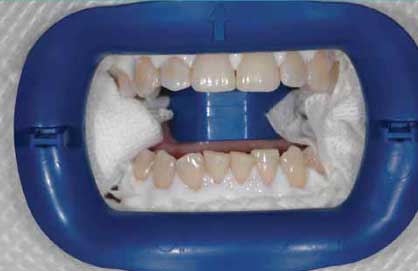Possible Side Effects

During Whitening
The second potential side effect to discuss is tooth sensitivity, which may be due to the status of the patient’s dentition or occur as a result of the process of tooth whitening. Prior to undertaking any whitening treatment, it is essential to evaluate the patient for recession, exposed dentin, leaking restorations and cavities. Any of these may be a contraindication for tooth whitening if they cannot be managed either prior to or during treatment depending on the clinical presentation). The second potential side effect to discuss is tooth sensitivity, which may be due to the status of the patient’s dentition or occur as a result of the process of tooth whitening. Prior to undertaking any whitening treatment, it is essential to evaluate the patient for recession, exposed dentin, leaking restorations and cavities. Any of these may be a contraindication for tooth whitening if they cannot be managed either prior to or during treatment (depending on the clinical presentation). If the whitening gel is applied directly to open margins or cavities, it can be extremely painful, and applying whitening gel to any exposed dentin also causes pain and sensitivity. The patient can still be a candidate for whitening treatment, but needs to have the cavities filled or leaking restorations replaced before tooth whitening is performed.
During the tooth whitening procedure, hydrogen peroxide diffuses through the enamel and reaches the inner dentin of the teeth. When in direct contact with exposed dentin, the peroxide breaks down microscopic debris that blocks the openings to the tubules that radiate from the pulp to the surface of the dentin. The fluid within the dentinal tubules moves backward and forward, stimulating the nerve fibers and resulting in tooth sensitivity (pain) in reaction to stimuli such as heat and cold.11 For in-office whitening, the most important steps in the procedure are careful placement of the liquid dam, being certain that the tissue is dry, verify all gingival tissue is covered and that dentin is sealed. It is better to have a little bit of liquid dam overlap on the enamel than to come up short and possibly expose dentin or gingiva.
Managing Sensitivity
Some reasons behind sensitivity could be time of exposure to the whitening agents as well as prolonged exposure to whitening accelerators. Also, some whitening gel formulations may not be efficient enough to help with sensitivity concerns. GloboDent’s In-Office BlanQuest® Pro Teeth Whitening Gel has been designed through both its fast procedures and its formulation, to significantly reduce such risks. The procedure itself is fast with or without the use of a whitening accelerator, allowing for a comfortable and decreasing the risk of sensitivity to occur. Also, it’s gel composition is made with gentle and highly effective ingredients that combined with its PH balance, have been formulated to keep sensitivity risks at a minimum.
Taking precautions to reduce sensitivity is very important. There are many options to reduce and, if necessary, treat sensitivity associated with tooth whitening. Having the patient use a desensitizing toothpaste containing potassium nitrate for two weeks prior to the whitening procedure can reduce sensitivity. Other options include using a whitening agent such as GloboDent’s Remineralizing Gel containing potassium nitrate. In rare cases where sensitivity following tooth whitening does not subside sufficiently, prescription pain relievers can be given or ibuprofen can be recommended. If all precautions are taken against sensitivity, sensitivity risks should be minimized, but because of the potential of post-whitening sensitivity, it is important to always remind patients of this possibility and to contact their dentists for any concerns.
